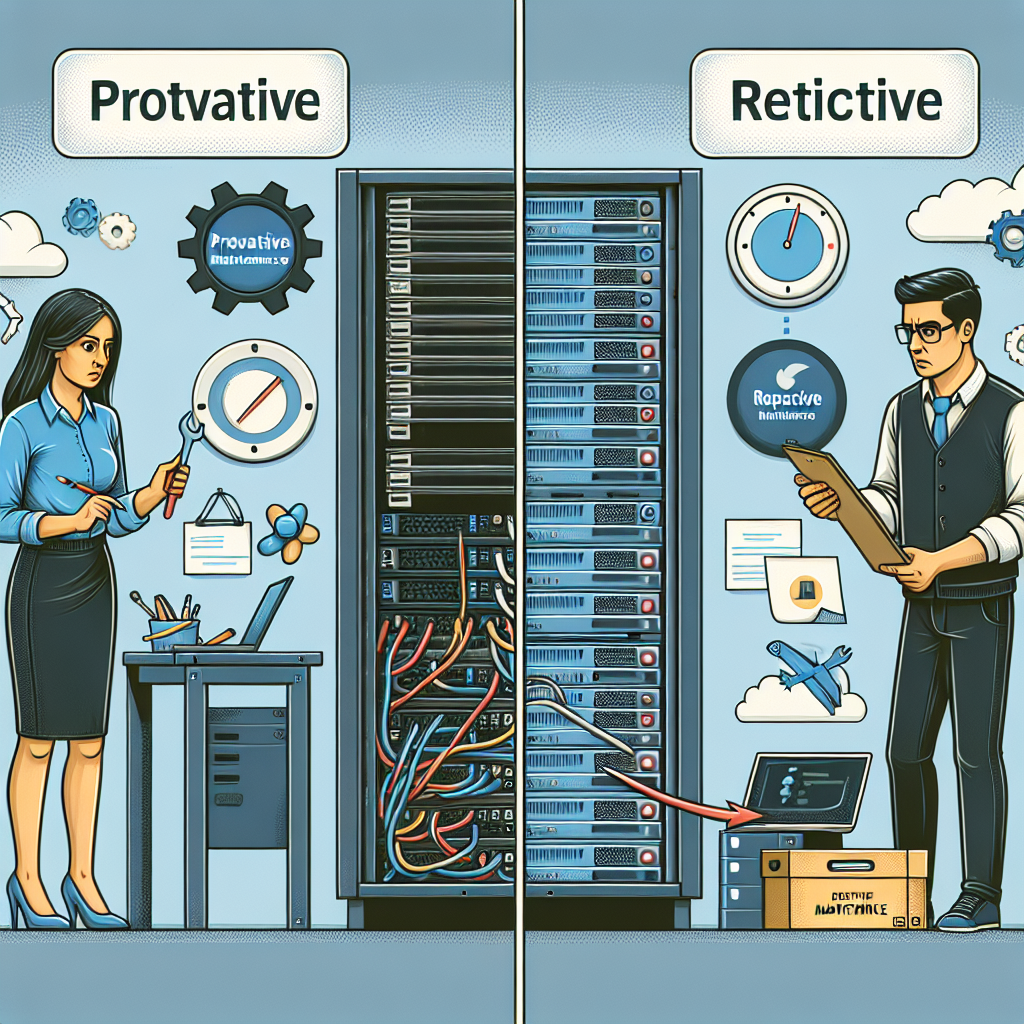Your cart is currently empty!
Tag: Proactive

Implementing a Proactive Maintenance Strategy for Data Centers
Data centers are the backbone of modern businesses, housing critical IT infrastructure that supports daily operations. As such, it is essential for data center managers to implement a proactive maintenance strategy to ensure optimal performance and minimize the risk of downtime.Proactive maintenance involves identifying and addressing potential issues before they escalate into major problems. By taking a proactive approach, data center managers can prevent costly downtime, increase efficiency, and extend the lifespan of equipment.
Here are some key steps to implementing a proactive maintenance strategy for data centers:
1. Regular Inspections: Conduct regular inspections of equipment and infrastructure to identify any signs of wear or potential issues. This includes checking for loose cables, overheating equipment, and any other anomalies that may indicate a problem.
2. Implement Monitoring Tools: Utilize monitoring tools to track the performance of equipment and identify any potential issues before they impact operations. This can include temperature sensors, power monitoring tools, and other monitoring software to keep track of system health.
3. Develop a Maintenance Schedule: Create a maintenance schedule that outlines regular maintenance tasks, such as cleaning equipment, replacing filters, and conducting routine tests. By following a schedule, data center managers can ensure that maintenance tasks are completed in a timely manner.
4. Train Staff: Ensure that staff are properly trained on how to identify and address maintenance issues. Provide training on best practices for equipment maintenance, as well as how to use monitoring tools effectively.
5. Document Maintenance Procedures: Keep detailed records of maintenance procedures, including when tasks were completed and any issues that were identified. This documentation can help track trends over time and identify areas for improvement.
6. Implement Redundancy: Implementing redundancy in critical systems can help minimize the impact of equipment failures. This can include backup power supplies, redundant cooling systems, and failover mechanisms to ensure uninterrupted operations.
By implementing a proactive maintenance strategy, data center managers can improve the reliability and efficiency of their operations. By regularly inspecting equipment, utilizing monitoring tools, developing a maintenance schedule, training staff, documenting procedures, and implementing redundancy, data centers can minimize the risk of downtime and ensure optimal performance. Ultimately, a proactive maintenance strategy can help businesses maintain a competitive edge in today’s fast-paced digital landscape.

Enhancing Data Center MTBF Through Proactive Maintenance Strategies
Data centers are the backbone of modern businesses, providing the infrastructure needed to store, process, and transmit vast amounts of data. As such, maximizing the uptime of data center equipment is crucial for ensuring the smooth operation of business-critical applications and services. One key metric for measuring the reliability of data center equipment is Mean Time Between Failures (MTBF), which represents the average time between equipment failures.Proactive maintenance strategies are essential for enhancing data center MTBF and minimizing the risk of unplanned downtime. By taking a proactive approach to maintenance, data center operators can identify and address potential issues before they escalate into costly failures. Here are some proactive maintenance strategies that can help enhance data center MTBF:
1. Regular equipment inspections: Regular inspections of data center equipment can help identify signs of wear and tear, loose connections, or other potential issues that could lead to equipment failures. By conducting regular inspections, data center operators can proactively address issues before they impact the reliability of the equipment.
2. Predictive maintenance: Predictive maintenance uses data analytics and machine learning algorithms to predict when equipment is likely to fail based on historical performance data. By analyzing patterns in equipment performance, data center operators can proactively schedule maintenance activities to prevent failures before they occur.
3. Condition-based monitoring: Condition-based monitoring involves monitoring key performance indicators (KPIs) such as temperature, humidity, and power consumption to identify potential issues with data center equipment. By monitoring these KPIs in real-time, data center operators can proactively address issues before they impact equipment reliability.
4. Spare parts management: Maintaining a stock of spare parts for critical data center equipment can help minimize downtime in the event of a failure. By proactively managing spare parts inventory, data center operators can quickly replace failed components and restore equipment functionality.
5. Regular software updates: Keeping data center software up to date is crucial for ensuring the security and reliability of data center equipment. By regularly updating software and firmware, data center operators can proactively address vulnerabilities and bugs that could lead to equipment failures.
In conclusion, enhancing data center MTBF through proactive maintenance strategies is essential for ensuring the reliability and uptime of data center equipment. By implementing regular equipment inspections, predictive maintenance, condition-based monitoring, spare parts management, and software updates, data center operators can proactively address potential issues and minimize the risk of unplanned downtime. Investing in proactive maintenance strategies can help businesses maximize the efficiency and reliability of their data center operations.

Maximizing ROI with Proactive Data Center Servicing: Strategies for Cost-Effective Maintenance
In today’s fast-paced business environment, data centers have become the backbone of operations for many organizations. These facilities house the critical infrastructure that supports all digital activities, from processing transactions to storing customer information. As such, it is crucial for businesses to ensure the reliability and efficiency of their data centers to maximize return on investment (ROI).One of the most effective ways to achieve this goal is through proactive data center servicing. By implementing regular maintenance and monitoring practices, organizations can prevent costly downtime and equipment failures, ultimately saving time and money in the long run. In this article, we will discuss strategies for cost-effective maintenance that can help businesses maximize ROI on their data center investments.
Regular Inspections and Preventive Maintenance
Regular inspections and preventive maintenance are essential components of proactive data center servicing. By conducting routine checks on equipment and systems, organizations can identify potential issues before they escalate into major problems. This proactive approach can help prevent downtime and costly repairs, ultimately saving businesses time and money.
Some key areas to focus on during inspections include cooling systems, power distribution units, and backup generators. By ensuring that these components are functioning properly, organizations can maintain the reliability and efficiency of their data centers.
Remote Monitoring and Management
Remote monitoring and management tools can also play a crucial role in proactive data center servicing. These tools allow IT teams to monitor the performance of equipment and systems in real-time, enabling them to identify and address issues before they impact operations.
By leveraging remote monitoring and management tools, organizations can optimize the performance of their data centers and maximize ROI. These tools can help businesses identify trends and patterns in data center performance, allowing them to make informed decisions about maintenance and upgrades.
Regular Training and Education
Regular training and education for data center staff are also essential for maximizing ROI. By keeping employees up-to-date on best practices and emerging technologies, organizations can ensure that their data centers are operating at peak efficiency.
Training and education can help employees identify and address issues quickly, reducing downtime and minimizing the impact on operations. Additionally, well-trained staff can help businesses make informed decisions about maintenance and upgrades, ultimately maximizing ROI on data center investments.
Outsourcing Maintenance Services
Outsourcing maintenance services can also be a cost-effective strategy for proactive data center servicing. By partnering with a third-party provider, organizations can access specialized expertise and resources that may not be available in-house.
Outsourcing maintenance services can help businesses reduce costs and improve efficiency by leveraging the expertise of experienced professionals. Additionally, outsourcing can help organizations free up internal resources to focus on core business activities, ultimately maximizing ROI on data center investments.
In conclusion, proactive data center servicing is essential for maximizing ROI on data center investments. By implementing regular inspections, preventive maintenance, remote monitoring and management, regular training and education, and outsourcing maintenance services, organizations can ensure the reliability and efficiency of their data centers. By taking a proactive approach to maintenance, businesses can prevent costly downtime and equipment failures, ultimately saving time and money in the long run.

Proactive Measures for Preventing Data Center Downtime
Data center downtime can be a costly and disruptive event for any organization. Not only does it result in lost productivity and revenue, but it can also damage a company’s reputation and customer trust. Therefore, it is crucial for businesses to take proactive measures to prevent data center downtime. Here are some key strategies to help mitigate the risk of downtime:Regular Maintenance and Monitoring: One of the most important proactive measures for preventing data center downtime is to conduct regular maintenance and monitoring of all equipment and systems. This includes conducting routine inspections, updating software and firmware, and monitoring key performance indicators to identify any potential issues before they escalate into major problems.
Redundancy and Backup Systems: Another critical proactive measure is to implement redundancy and backup systems for all critical components of the data center, including power supplies, cooling systems, and network connections. By having redundant systems in place, businesses can ensure that if one system fails, there is a backup system ready to take over, minimizing the risk of downtime.
Disaster Recovery Planning: It is also essential for organizations to have a comprehensive disaster recovery plan in place to ensure that they can quickly and effectively recover from any potential downtime event. This includes having backup data centers, offsite storage facilities, and clear protocols for how to respond in the event of a disaster.
Regular Testing and Training: Regular testing and training of staff are essential proactive measures to prevent data center downtime. By conducting regular drills and training sessions, organizations can ensure that their staff are prepared to respond quickly and effectively in the event of an outage or other emergency.
Security Measures: In addition to technical measures, implementing robust security measures is also crucial for preventing data center downtime. This includes implementing strong access controls, monitoring for suspicious activity, and regularly updating security protocols to protect against cyber threats.
By taking proactive measures such as regular maintenance and monitoring, implementing redundancy and backup systems, disaster recovery planning, regular testing and training, and robust security measures, organizations can significantly reduce the risk of data center downtime. Investing in these measures can help businesses protect their critical data and ensure that they can continue to operate smoothly and efficiently in the event of an outage.

Proactive vs. Reactive Server Maintenance: Which Approach is Best for Your Business?
In the world of server maintenance, there are two main approaches that businesses can take: proactive and reactive. Each approach has its own set of advantages and disadvantages, and choosing the right one for your business can have a significant impact on your bottom line.Proactive server maintenance involves regularly monitoring and maintaining your servers to prevent issues from occurring in the first place. This can include tasks such as updating software, replacing hardware components before they fail, and optimizing server performance. By taking a proactive approach to server maintenance, businesses can minimize downtime, improve system reliability, and reduce the risk of data loss.
On the other hand, reactive server maintenance involves addressing issues as they arise. This approach is often seen as a more cost-effective option, as businesses only need to invest resources when a problem occurs. However, reactive maintenance can lead to increased downtime, higher repair costs, and a greater risk of data loss.
So, which approach is best for your business? The answer depends on a variety of factors, including the size of your business, your budget, and the criticality of your servers.
For larger businesses with complex server infrastructures and high uptime requirements, a proactive maintenance approach is often the best choice. By investing in regular maintenance and monitoring, these businesses can ensure that their servers are running smoothly and avoid costly downtime.
On the other hand, smaller businesses with limited resources may opt for a reactive maintenance approach. While this approach may lead to higher costs in the long run, it can be a more practical solution for businesses with limited budgets.
Ultimately, the best approach to server maintenance will depend on your specific business needs and goals. By carefully considering your options and weighing the pros and cons of each approach, you can make an informed decision that will help ensure the smooth operation of your servers and the success of your business.

Maximizing Data Center Performance through Proactive Facilities Management
In today’s digital age, data centers are the backbone of many organizations’ operations. These facilities house the servers, storage, and networking equipment that support critical business functions and store valuable data. With the increasing reliance on technology, it is more important than ever to ensure that data centers are operating at peak performance to support the demands of the business.One way to maximize data center performance is through proactive facilities management. This approach involves actively monitoring and managing the physical infrastructure of the data center to ensure that it is operating efficiently and reliably. By taking a proactive approach to facilities management, organizations can prevent downtime, optimize energy efficiency, and extend the lifespan of their data center equipment.
One key aspect of proactive facilities management is monitoring and managing the temperature and humidity levels in the data center. Maintaining the optimal environmental conditions is crucial for the proper functioning of the equipment housed in the data center. High temperatures and humidity levels can lead to equipment failure and downtime, while low temperatures can increase energy consumption. By closely monitoring and controlling the environmental conditions in the data center, organizations can ensure that their equipment is operating at peak performance.
Another important aspect of proactive facilities management is performing regular maintenance and inspections of the data center equipment. By conducting routine maintenance tasks such as cleaning, testing, and replacing components, organizations can prevent equipment failures and extend the lifespan of their data center equipment. Regular inspections can also help identify potential issues before they escalate into larger problems, allowing organizations to address them proactively.
In addition to monitoring environmental conditions and performing regular maintenance, organizations can also maximize data center performance through energy management. By implementing energy-efficient practices such as virtualization, consolidation, and optimized cooling strategies, organizations can reduce energy consumption and lower operating costs. Energy management initiatives can also help organizations meet sustainability goals and reduce their carbon footprint.
Overall, proactive facilities management is essential for maximizing data center performance. By closely monitoring environmental conditions, performing regular maintenance, and implementing energy-efficient practices, organizations can ensure that their data centers are operating at peak performance to support the demands of the business. Investing in proactive facilities management can lead to increased reliability, efficiency, and cost savings for organizations that rely on their data centers for critical business operations.

The Importance of Proactive Problem Management in Data Centers
Data centers are the backbone of modern businesses, housing the critical infrastructure that supports a company’s operations. With the increasing reliance on digital technologies, the importance of data centers has never been more pronounced. However, data centers are not immune to problems and issues that can disrupt operations and impact performance. This is where proactive problem management comes into play.Proactive problem management is the practice of identifying and addressing potential issues before they escalate into major problems. By taking a proactive approach to problem management, data center operators can prevent downtime, minimize disruptions, and ensure the smooth and efficient operation of their facilities.
One of the key benefits of proactive problem management in data centers is the ability to anticipate and address issues before they impact operations. By monitoring key performance indicators and conducting regular assessments of equipment and systems, data center operators can identify potential problems early on and take corrective action to prevent downtime.
Another important aspect of proactive problem management is the ability to prioritize and address issues based on their impact on operations. By categorizing and prioritizing problems, data center operators can focus their resources on addressing the most critical issues first, ensuring that the most important systems and services are protected.
In addition, proactive problem management can help data center operators improve the efficiency and reliability of their facilities. By identifying and addressing underlying causes of problems, operators can implement long-term solutions that prevent recurring issues and improve overall performance.
Furthermore, proactive problem management can help data center operators reduce costs associated with downtime and emergency repairs. By addressing potential issues before they become major problems, operators can avoid costly repairs and minimize the impact of downtime on operations.
Overall, proactive problem management is essential for ensuring the smooth and efficient operation of data centers. By taking a proactive approach to problem management, data center operators can prevent downtime, minimize disruptions, and improve the reliability and performance of their facilities. Investing in proactive problem management is a smart decision for any organization that relies on data centers to support its operations.

Predictive Maintenance in Data Centers: A Proactive Approach to Preventing Downtime
In today’s digital age, data centers play a crucial role in storing, processing, and managing vast amounts of data. With the increasing reliance on data centers for various business operations, any downtime can have severe consequences, including financial losses and reputational damage. This is where predictive maintenance comes in as a proactive approach to preventing downtime and ensuring the smooth operation of data centers.Predictive maintenance involves using data and analytics to predict when equipment is likely to fail so that maintenance can be performed before an issue occurs. By monitoring key performance indicators and trends, data center operators can identify potential problems early on and take corrective action to prevent downtime.
One of the main benefits of predictive maintenance is that it helps data center operators move from a reactive to a proactive maintenance strategy. Instead of waiting for equipment to fail and then fixing it, predictive maintenance allows operators to address issues before they disrupt operations. This not only minimizes downtime but also reduces maintenance costs and extends the lifespan of equipment.
Another advantage of predictive maintenance is that it can improve operational efficiency in data centers. By identifying and addressing potential issues early on, operators can optimize their maintenance schedules and resources, leading to more efficient operations and reduced downtime.
To implement predictive maintenance in data centers, operators can use a combination of sensors, monitoring tools, and predictive analytics software. These technologies can collect real-time data on equipment performance, analyze trends and patterns, and generate alerts when anomalies are detected. By leveraging these tools, operators can make data-driven decisions and proactively manage their maintenance activities.
In conclusion, predictive maintenance is a proactive approach that can help data center operators prevent downtime and ensure the reliable operation of their facilities. By using data and analytics to predict equipment failures and address issues early on, operators can optimize their maintenance practices, improve operational efficiency, and minimize the risk of costly downtime. As data centers continue to play a critical role in the digital economy, predictive maintenance will become an essential strategy for maintaining the reliability and performance of these facilities.

Managing Data Center Downtime with Proactive Reactive Maintenance Strategies
Data center downtime can be a costly and disruptive event for any organization. In today’s digital age, businesses rely heavily on their data centers to store and manage critical information, applications, and services. A single minute of downtime can result in significant financial losses and damage to a company’s reputation. To mitigate the risks associated with data center downtime, organizations must implement proactive and reactive maintenance strategies to ensure the smooth operation of their data centers.Proactive maintenance involves taking preventative measures to identify and address potential issues before they escalate into major problems. This can include regular equipment inspections, software updates, and performance monitoring. By proactively managing data center infrastructure, organizations can reduce the likelihood of unexpected downtime and minimize the impact of any disruptions that do occur.
One key aspect of proactive maintenance is conducting regular equipment inspections and maintenance checks. This involves monitoring the performance of critical infrastructure components such as servers, cooling systems, and power supplies to identify any signs of wear or potential failure. By addressing issues early on, organizations can avoid unexpected downtime and ensure the reliability of their data center operations.
In addition to proactive maintenance, organizations must also have a solid reactive maintenance strategy in place to quickly address any issues that arise. Reactive maintenance involves responding to unexpected failures or disruptions in real-time to minimize the impact on data center operations. This can include troubleshooting problems, replacing faulty equipment, and restoring services as quickly as possible.
To effectively manage data center downtime, organizations should have a comprehensive maintenance plan that combines proactive and reactive strategies. This plan should include regular maintenance schedules, emergency response protocols, and clear communication channels for notifying relevant stakeholders in the event of a downtime incident.
Furthermore, organizations should also consider implementing redundancy and failover mechanisms to ensure business continuity in the event of a data center outage. This can include backup power supplies, redundant cooling systems, and mirrored data storage to minimize the impact of any disruptions on critical operations.
By implementing proactive and reactive maintenance strategies, organizations can effectively manage data center downtime and ensure the reliability of their critical infrastructure. By investing in preventative measures and responding quickly to any issues that arise, organizations can minimize the risks associated with data center downtime and protect their business from potential financial losses and reputational damage.
